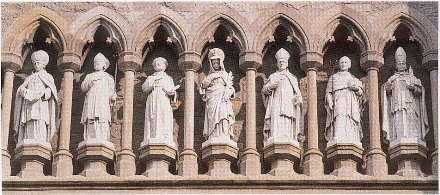
The Gothic revival movement coincided with Catholic Emancipation in Ireland and Britain, and the consequent need to find symbols to express public worship which had been driven underground for over two centuries. This accounts for the outstanding feature of Monaghan Cathedral, which both in its imposing walls and soaring spire, is the emphasis on height.
The plan of the building is in the form of Latin cross. The nave (or body) of the church, running west to east, constitutes the shaft of the cross. Unfortunately for the overall proportions of the building, only five of the seven planned bays of the nave were built. The arms to the north and south, the transepts, have entrances on either side from the chapter house and the tower. At the crossing of nave and transepts we have the beginning of the chancel, which reaches eastwards into the apse. On either side of the nave are the side aisles and opening from the eastern sides of the transepts are four side chapels, two on each side. The Lady chapel, formerly the baptistery, projects off the north aisle.
The variety of Gothic architecture adopted by McCarthy here is known as Decorated, or fourteenth-century French. The main features of this style are obvious from the outside; the large rose and lancet windows adorned with elaborate tracery, the pointed arches and doors, the numerous turrets and pinnacles, and the thick, stepped buttresses separating the bays. The buttresses of the apse and Lady chapel are especially noteworthy. The polygonal form of the apse or ‘chevet’ is a distinctively French feature: in medieval English architecture a square, eastern termination was always preferred. Another characteristic of French Gothic, as opposed to English, was its far greater emphasis on height.

